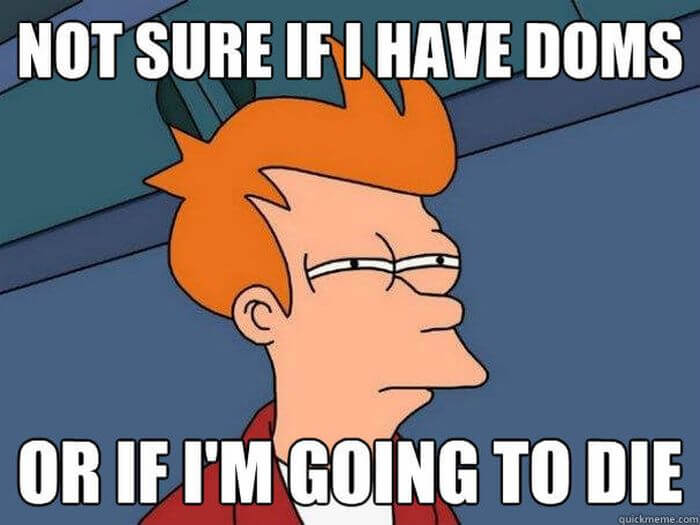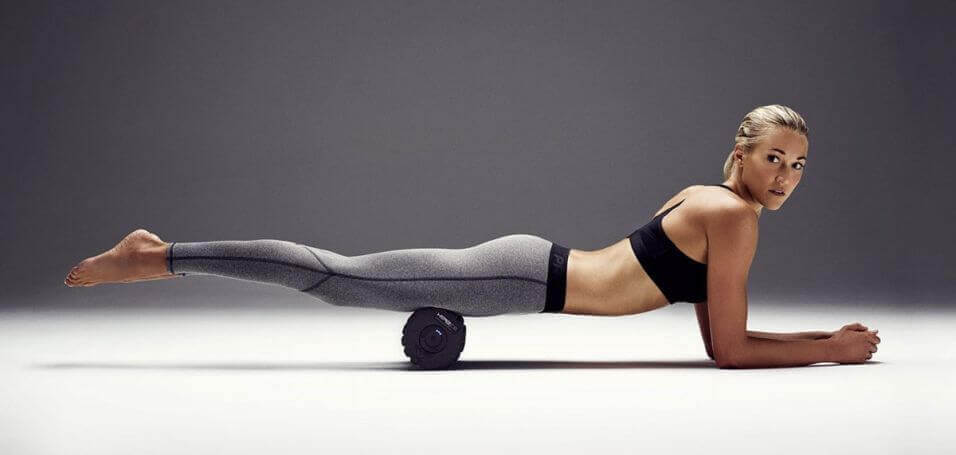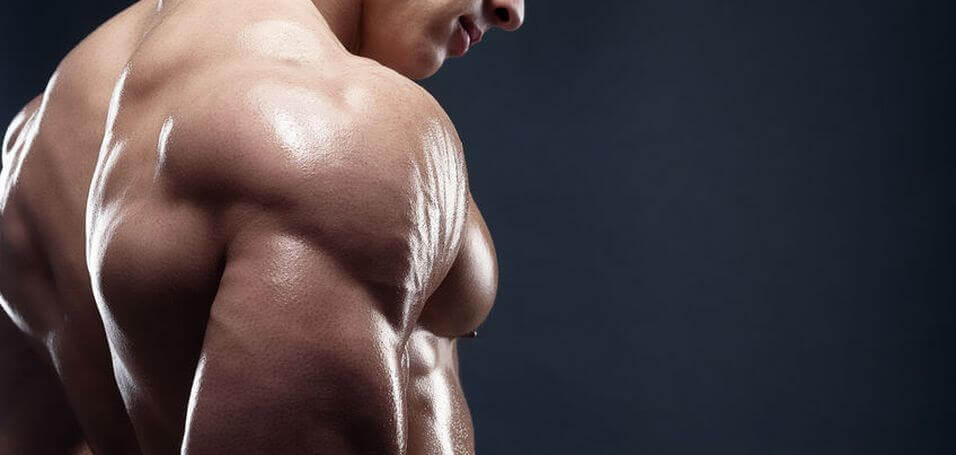If you’re into weightlifting, you’ve become very acquainted with sore muscles.
You’ve done many reps of the “half-squat-toilet-fall.”
You’ve had the “is this just muscle soreness or am I actually dying?” thoughts.
And maybe you’ve even gone full Stockholm syndrome and now crave the daily debilitation.
Well, I’ve been there, I’ve learned some things, and now I’m going to pass on those lessons.
You see, like many people, I used to think muscle soreness was pretty black and white.
I assumed that sore muscles were a sign that I was doing something right, and the more sore I was, the more effective my workouts were.
(And as a corollary, I worried that workouts that produced little soreness also produced little results.)
Well, it turns out it’s not that simple.
Years ago, I used to do workouts that produced a tremendous amount of muscle soreness…and I made mediocre (at best) gains.
After dramatically changing the way I trained, however, I experienced far less muscle soreness but made far better progress.
In this article, I’m going to explain why that is and what you need to know about sore muscles and training to optimize your results.
Let’s get started.
Table of Contents
+Want to listen to more stuff like this? Check out my podcast!
Why Do Muscles Get Sore?
It was once believed that muscle soreness was caused by a buildup of lactic acid.
We now know that’s not true.
It was then hypothesized that it was caused solely by microscopic tears in the muscles.
This makes more sense mechanically, but we now know that there’s more to the story than muscle damage alone.
Muscle damage (“microtears”) certainly plays a role in the physiology of muscle soreness, but there are other factors involved.
We can start with research conducted by scientists at Yokohama City University found that damaged muscles don’t necessarily hurt and muscles that hurt aren’t necessarily much damaged.
How could that be, you wonder?
Well, a study conducted by scientists at Concordia University lends insight.
It demonstrated that at least some of the pain of muscle soreness stems from the connective tissue holding muscle fibers together, not from the actual fibers themselves.
That is, what you think is “muscle soreness” is at least partially (if not more) “connective tissue” soreness.
We also know that muscle soreness is influenced by other factors including your training protocol, diet, recovery regimen, genetics, and more.
This helps explain why some people get more sore than others from the same workouts.
So, as with muscle growth, we still have much to learn about what is really happening when we feel our muscles are sore.
Fortunately, however, we do know enough about how soreness relates to muscle growth to gain some practical insights about how to make better gains.
Before we talk about that, though, let’s talk about the specific type of muscle soreness us weightlifting folk experience…
What Is Delayed Onset Muscle Soreness (DOMS)?

Delayed onset muscle soreness (also referred to as DOMS) is exactly what it sounds like:
The muscle soreness that hits you a day or two after you work out.
It’s worst for people new to resistance training, some exercises produce more DOMS than others, and, thanks to the “repeated bout effect,” it’s mitigated by repeated performance of the same types of exercise.
Interestingly, research shows that the eccentric (lengthening) phase of a movement causes more muscle soreness than the concentric (contraction) phase. This applies to weightlifting, of course (which anyone who does a lot of heavy “negative” reps can attest to), but to other activities like running as well.
For example, studies show that, in the same people, running on a level surface can produce no muscle soreness but downhill running–which involves more eccentric stress in the hip and leg muscles–can produce considerable soreness.
Again, the exact mechanisms behind this aren’t fully understood, but it gives us enough to segue into the next question on most weightlifter’s minds…
Does Muscle Soreness Mean Muscle Growth?

I used to think that perpetual muscle soreness was simply a price you had to pay to build muscle.
In time, I almost thought of it as a badge of honor.
(“Damn straight I have to walk down stairs backwards! My legs are going to be YUGE!”
Well, I was wrong.
In fact, there is, in a way, an inverse relationship between muscle soreness and muscle growth.
That is, the more sore you get from your workouts, the less muscle you’re probably building over time.
To understand why, let’s quickly review the three primary drivers of muscle growth:
1. Progressive overload
This refers to increasing tension levels in the muscle fibers over time.
2. Metabolic stress
This refers to pushing muscle fibers to their metabolic limits through the repetition of actions to muscular failure.
3. Muscle damage
This refers to actual damage caused to the muscle fibers by high levels of tension.
When we’re talking muscle soreness, we’re most interested in door number three–muscle damage–and the assumptions that many people make it about:
- Muscle damage is vital to muscle growth.
- Muscle soreness is a reliable indicator of muscle damage.
- Hence, muscle soreness is associated with muscle growth.
Let’s take a closer look at these beliefs.
First, research shows that muscle damage contributes to muscle growth but isn’t a requirement.
(That is, workouts that cause little to no muscle damage can still result in muscle growth.)
Furthermore, while a certain degree of muscle damage can accelerate muscle growth, too much compromises it.
Picture the relationship between muscle damage and growth like this: ∩.
Both too little and too much damage are bad and in the middle is an optimal “sweet spot.”
(If you want to get an idea of where most people’s “sweet spot” lies, check out this article.)
Further complicating matters is the fact that the degree of muscle soreness you experience after workouts isn’t a reliable indicator of the degree of muscle damage (and muscle growth) produced.
In other words, a high or low amount of muscle soreness doesn’t necessarily reflect a high or low amount of muscle damage or muscle growth.
There are several other observations that serve as further evidence of the disconnect between muscle soreness and muscle building:
- People that train infrequently build far less muscle but experience far more muscle soreness than those that train more frequently.
- Muscle soreness generally decreases as training frequency increases, which can accelerate muscle growth.
- Muscles like the shoulders and calves generally don’t get very sore from training but can grow fairly easily.
So, the bottom line is this:
Some people experience more or less muscle soreness (DOMS) than others, but it’s not a prerequisite to or reliable sign of muscle growth.
The goal of your training is progression, not soreness.
Can You Work Out When Your Muscles Are Sore?

Yes.
Despite what you’ve probably heard, training sore muscles doesn’t necessarily hinder recovery and prevent muscle growth.
That said, we recall that, regardless of the presence or absence of muscle soreness, intense workouts do cause muscle damage that must be repaired before the muscles are ready for another round.
That’s why training too intensely too frequently can impair your gains.
(If you’re curious as to what’s optimal for both training intensity and frequency, check out this article.)
How to Get Rid of Sore Muscles

If you’re training, eating, and recovering properly, you probably won’t suffer from bone deep, agonizing muscle soreness.
That said, a certain degree of tenderness is inevitable, and your experience with it may be worse than others’.
That’s why I want to cover several things you can do to reduce muscle soreness and, in some cases, speed up recovery as well.
Massage
Research shows that massage is an effective way to reduce DOMS.
(Massage therapy confers a variety of health benefits as well.)
Foam Rolling
A study conducted by researchers at Charles Sturt University found that foam rolling reduces the severity of DOMS and increases range of motion.
You can learn more about how to foam roll here.
Active Recovery
Active recovery is light exercise that is far easier than your normal routine. Examples are yoga, walking, bicycling, and swimming.
Research shows that active recovery can help reduce muscle soreness from your more intense training.
I’ve found yoga to be particularly helpful in this regard, which has been seen in studies as well.
Take the Right Supplements
Most supplements related to muscle recovery and muscle building are worthless.
That said, I do like (and use) two:
Creatine
Creatine is the most well-researched molecule in all of sports nutrition.
Hundreds of clinical studies have been done on it and the benefits are clear:
- It helps you build muscle faster.
- It helps you get stronger faster.
- It improves anaerobic endurance.
- It improves muscle recovery.
What isn’t so clear, though, is which form you should take and why.
Check out this article to learn more.
L-Carnitine L-Tartrate
Carnitine is a compound that your body produces from the amino acids lysine and methionine. It plays a vital role in the generation of cellular energy.
L-tartrate is a salt used to increase the absorption of other nutrients.
Research shows that supplementation with L-carnitine L-tartrate reduces exercise-induced muscle damage and muscle soreness and improves muscle repair.
This is why I included it in my post-workout supplement RECHARGE.
(Oh, and if you aren’t sure if the supplements discussed in this article are right for your budget, circumstances, and goals, then take the Legion Supplement Finder Quiz! In less than a minute, it’ll tell you exactly what supplements are right for you. Click here to check it out.)
The Bottom Line on Sore Muscles

Muscle soreness isn’t nearly as important as many people think.
It’s more of a sign that you subjected your body to something it isn’t used to or that you simply did an exercise known to cause more soreness than a sign of an “effective workout.”
So don’t worry if your workouts don’t make you sore. It doesn’t mean you’re not building muscle.
Don’t do workouts just because they make you very sore, either. They won’t necessarily help you build muscle faster (in most cases, the opposite will probably be true).
Focus on training hard, eating right, recovering fully, and you’ll reach your goals, sore or otherwise.
What’s your take on sore muscles? Have anything else to share? Let me know in the comments below!
Scientific References +
- Cheung, K., Hume, P. A., & Maxwell, L. (2003). Delayed onset muscle soreness: Treatment strategies and performance factors. In Sports Medicine (Vol. 33, Issue 2, pp. 145–164). Sports Med. https://doi.org/10.2165/00007256-200333020-00005
- Nosaka, K., Newton, M., & Sacco, P. (2002). Delayed-onset muscle soreness does not reflect the magnitude of eccentric exercise-induced muscle damage. Scandinavian Journal of Medicine and Science in Sports, 12(6), 337–346. https://doi.org/10.1034/j.1600-0838.2002.10178.x
- Crameri, R. M., Aagaard, P., Qvortrup, K., Langberg, H., Olesen, J., & Kjær, M. (2007). Myofibre damage in human skeletal muscle: Effects of electrical stimulation versus voluntary contraction. Journal of Physiology, 583(1), 365–380. https://doi.org/10.1113/jphysiol.2007.128827
- Hubal, M. J., Devaney, J. M., Hoffman, E. P., Zambraski, E. J., Gordish-Dressman, H., Kearns, A. K., Larkin, J. S., Adham, K., Patel, R. R., & Clarkson, P. M. (2010). CCL2 and CCR2 polymorphisms are associated with markers of exercise-induced skeletal muscle damage. Journal of Applied Physiology, 108(6), 1651–1658. https://doi.org/10.1152/japplphysiol.00361.2009
- Newham, D. J., Jones, D. A., Ghosh, G., & Aurora, P. (1988). Muscle fatigue and pain after eccentric contractions at long and short length. Clinical Science, 74(5), 553–557. https://doi.org/10.1042/cs0740553
- McHugh, M. P. (2003). Recent advances in the understanding of the repeated bout effect: The protective effect against muscle damage from a single bout of eccentric exercise. In Scandinavian Journal of Medicine and Science in Sports (Vol. 13, Issue 2, pp. 88–97). Scand J Med Sci Sports. https://doi.org/10.1034/j.1600-0838.2003.02477.x
- Eston, R. G., Mickleborough, J., & Baltzopoulos, V. (1995). Eccentric activation and muscle damage: biomechanical and physiological considerations during downhill running. British Journal of Sports Medicine, 29(2), 89–94. https://doi.org/10.1136/bjsm.29.2.89
- Mikkelsen, U. R., Langberg, H., Helmark, I. C., Skovgaard, D., Andersen, L. L., Kjær, M., & Mackey, A. L. (2009). Local NSAID infusion inhibits satellite cell proliferation in human skeletal muscle after eccentric exercise. Journal of Applied Physiology, 107(5), 1600–1611. https://doi.org/10.1152/japplphysiol.00707.2009
- Schoenfeld, B. J. (2010). The mechanisms of muscle hypertrophy and their application to resistance training. In Journal of Strength and Conditioning Research (Vol. 24, Issue 10, pp. 2857–2872). J Strength Cond Res. https://doi.org/10.1519/JSC.0b013e3181e840f3
- Flann, K. L., Lastayo, P. C., McClain, D. A., Hazel, M., & Lindstedt, S. L. (2011). Muscle damage and muscle remodeling: No pain, no gain? Journal of Experimental Biology, 214(4), 674–679. https://doi.org/10.1242/jeb.050112
- Chen, T. C., & Nosaka, K. (2006). Responses of elbow flexors to two strenuous eccentric exercise bouts separated by three days. Journal of Strength and Conditioning Research, 20(1), 108–116. https://doi.org/10.1519/R-16634.1
- Chapman, D., Newton, M., Sacco, P., & Nosaka, K. (2006). Greater muscle damage induced by fast versus slow velocity eccentric exercise. International Journal of Sports Medicine, 27(8), 591–598. https://doi.org/10.1055/s-2005-865920
- Moyer, C. A., Rounds, J., & Hannum, J. W. (2004). A Meta-Analysis of Massage Therapy Research. Psychological Bulletin, 130(1), 3–18. https://doi.org/10.1037/0033-2909.130.1.3
- Macdonald, G. Z., Button, D. C., Drinkwater, E. J., & Behm, D. G. (2014). Foam rolling as a recovery tool after an intense bout of physical activity. Medicine and Science in Sports and Exercise, 46(1), 131–142. https://doi.org/10.1249/MSS.0b013e3182a123db
- Andersen, L. L., Jay, K., Andersen, C. H., Jakobsen, M. D., Sundstrup, E., Topp, R., & Behm, D. G. (2013). Acute effects of massage or active exercise in relieving muscle soreness: Randomized controlled trial. Journal of Strength and Conditioning Research, 27(12), 3352–3359. https://doi.org/10.1519/JSC.0b013e3182908610
- Boyle, C. A., Sayers, S. P., Jensen, B. E., Headley, S. A., & Manos, T. M. (2004). The effects of yoga training and a single bout of yoga on delayed onset muscle soreness in the lower extremity. Journal of Strength and Conditioning Research, 18(4), 723–729. https://doi.org/10.1519/14723.1
- Branch, J. D. (2003). Effect of creatine supplementation on body composition and performance: A meta-analysis. International Journal of Sport Nutrition and Exercise Metabolism, 13(2), 198–226. https://doi.org/10.1123/ijsnem.13.2.198
- Volek, J. S., Ratamess, N. A., Rubin, M. R., Gómez, A. L., French, D. N., McGuigan, M. M., Scheett, T. P., Sharman, M. J., Häkkinen, K., & Kraemer, W. J. (2004). The effects of creatine supplementation on muscular performance and body composition responses to short-term resistance training overreaching. European Journal of Applied Physiology, 91(5–6), 628–637. https://doi.org/10.1007/s00421-003-1031-z
- Eckerson, J. M., Stout, J. R., Moore, G. A., Stone, N. J., Iwan, K. A., Gebauer, A. N., & Ginsberg, R. (2005). Effect of creatine phosphate supplementation on anaerobic working capacity and body weight after two and six days of loading in men and women. Journal of Strength and Conditioning Research, 19(4), 756–763. https://doi.org/10.1519/R-16924.1
- Bassit, R. A., Pinheiro, C. H. D. J., Vitzel, K. F., Sproesser, A. J., Silveira, L. R., & Curi, R. (2010). Effect of short-term creatine supplementation on markers of skeletal muscle damage after strenuous contractile activity. European Journal of Applied Physiology, 108(5), 945–955. https://doi.org/10.1007/s00421-009-1305-1
- Kraemer, W. J., Volek, J. S., French, D. N., Rubin, M. R., Sharman, M. J., Gómez, A. L., Ratamess, N. A., Newton, R. U., Jemiolo, B., Craig, B. W., & Häkkinen, K. (2003). The effects of L-carnitine L-tartrate supplementation on hormonal responses to resistance exercise and recovery. Journal of Strength and Conditioning Research, 17(3), 455–462. https://doi.org/10.1519/1533-4287(2003)017<0455:TEOLLS>2.0.CO;2
- Ho, J. Y., Kraemer, W. J., Volek, J. S., Fragala, M. S., Thomas, G. A., Dunn-Lewis, C., Coday, M., Häkkinen, K., & Maresh, C. M. (2010). L-Carnitine l-tartrate supplementation favorably affects biochemical markers of recovery from physical exertion in middle-aged men and women. Metabolism: Clinical and Experimental, 59(8), 1190–1199. https://doi.org/10.1016/j.metabol.2009.11.012










